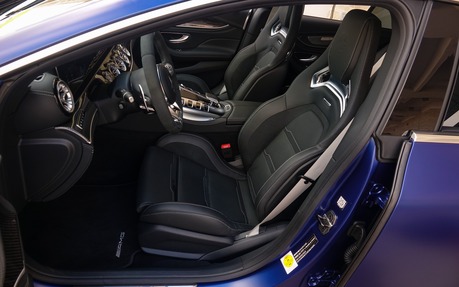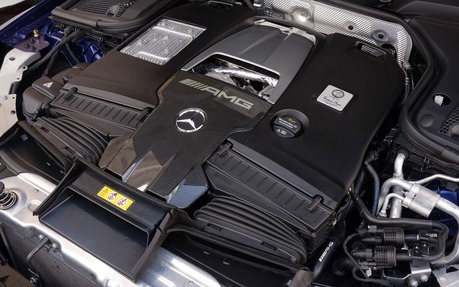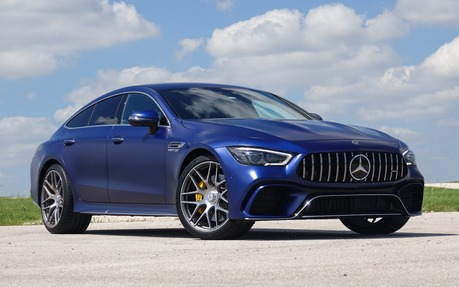2019 Mercedes-AMG GT 4-Door Coupe: All Bases Covered
AUSTIN, Texas – About a dozen years ago, when Mercedes-Benz first introduced the CLS, a thoroughbred among sedans, it represented a radical departure from the classic sedan formula. Built on the same architecture as the E-Class, the CLS was not only beautiful, but it handled better and was more fun to drive.
Of course, the success of the CLS led to copycats, and more rivals meant more power and higher prices. Over the years, we’ve seen the advent of the Aston Martin Rapide, Audi S7, BMW 6 Series Gran Coupé, Maserati Quattroporte and Porsche Panamera—and their RS 7, M6, GTS and Turbo versions following closely behind. Not to be outdone, the pioneer responded with the CLS 63 featuring a 577-horsepower, 5.5-litre twin-turbo V8.
- Also: 2019 Mercedes-AMG E 53 Coupe: Fun and Surprises
- Also: 2019 Mercedes-AMG GT 4-door Coupe: More Doors, More Fun for Everyone
This time, the AMG performance division is taking charge. Instead of developing sharper versions of the third-generation CLS, launched this fall as a 2019 model, the folks from Affalterbach created their own “four-door coupe,” which is only their third brand-new creation in more than a half-century.
The AMG way
Unlike the GT coupes and cabriolets, there’s no aluminum box section frame for the GT four-door coupe. Instead, it has a monocoque body using only the most essential elements of the MRA modular architecture, which also underlies the new E-Class and CLS. In addition to steel, there are many aluminum components along with high-strength steel braces and struts where the pressure is most intense. Moreover, the panels are made of carbon fibre. The result is a lighter body that’s ultra-rigid.

While the resemblance to the CLS is undeniable, the tapered-off roofline and large chrome whalebone strips that make up the aggressive grille leave no doubt as to the GT four-door coupe’s exclusive AMG roots. The silhouette is nearly identical for the GT 53, GT 63 and GT 63 S, although the first version offers a markedly different drivetrain.
The most notable differences are larger air intakes for the grille, four rectangular (as opposed to round) exhaust tips, and a larger diffuser for the GT 63 and GT 63 S, which really lays it on thick with a fixed spoiler and yellow brake callipers (instead of red). The GT 53’s brake callipers are silver and its front discs are 360 mm rather than 390 mm in diameter.
In the cabin, we like the two superbly clear digital screens that take up nearly two thirds of the dashboard, the half-dozen round air vents, and the new V-shaped central console—GT cabriolet and roadster style—with its clear and efficient electronic commands. The steering wheel is impeccable, draped in Nappa leather and loaded with useful and efficient buttons. It’s even better in the GT 63 S, which comes with an Alcantara rim, a pair of versatile buttons and an electronic scroll wheel to change driving modes and settings.
Engine talk
Under the GT 53’s long hood, there’s a new 3.0-litre inline-six simultaneously fed by a turbo and an electric compressor that eliminates lag and increases torque in low gear. Total output comes to 429 horsepower, to which are added 21 horsepower from the 48-volt starter-generator of the EQ Boost system, which recovers braking energy.

The result is flat-out linear accelerations and almost imperceptible restarts of the combustion engine after each stop. The advertised 0-100 km/h time of 4.5 seconds seems perfectly credible. Pedal to the metal in Sport+ mode, the deep sound—amplified God knows how—is reminiscent of the legendary 300SL Gullwing or even a Jaguar E-Type. One thing is certain: this new light hybrid powertrain is a wonder of performance and refinement with the added bonus of frugality.
In stark contrast, the GT 63 features a 4.0-litre twin-turbo V8 that generates 577 horsepower, with up to 630 horsepower in the GT 63 S. The latter completes the 0-100 km/h in 3.2 seconds, which is nothing short of staggering considering its weight of nearly two metric tonnes. That type of explosive power is made possible thanks to all-wheel drive and a launch control system.
Nearly opposite personalities
On the track, the roaring GT 63 S made short work of the straightaway at Circuit of the Americas and the optional carbon fibre brakes effortlessly erased the 250 km/h displayed on the speedometer as the vehicle entered the hairpin turn that follows. It also managed very well in the series of winding turns with the help of rear-wheel steering.
However, there was no hope of keeping up with pilots like Bernd Schneider or Jan Seyffarth in their GT coupe, which was lower, 350 kg lighter and nearly as powerful. The two-tonne GT 63 S reached its limit negotiating longer bends. All-wheel drive and torque transfer or not, the laws of physics are non-negotiable.
On the road, the GT 63 S is a tad skittish and bouncy, even in Comfort mode, while the GT 53 is agile, smooth and perfectly content, even in Sport+ mode. I’m curious to see and feel how it manages on a track, since the AMG division claims that ease on the track is the objective for all its creations. Otherwise, it’s a wonderfully agile and comfortable car that’s gratifying to drive.
The fiery GT 63 S is anxious to rip into its most muscular rivals. Whether you prefer a relaxed ride of full-throttle excitement, your choice will be easier once Mercedes-Benz announces the Canadian pricing of its four-door divas before they finally arrive in the spring.
| Test drive report | |
| Test model | 2019 Mercedes-Benz AMG GT |
|---|---|
| Trim level | 63S Coupe 4-door |
| Price range | N/A |
| Price as tested | N/A |
| Warranty (basic) | 4 years/80,000 km |
| Warranty (powertrain) | 4 years/80,000 km |
| Fuel economy (city/highway/observed) | N/A |
| Options | N/A |
| Competitive models | Maserati Quattroporte |
| Strong points |
|
| Weak points |
|
| Editor's rating | |
| Fuel economy | Very acceptable in these very sporty sedan-coupe variants, though different depending on each version’s purpose—and your right foot, of course. |
| Comfort | A balanced or firm ride, depending on the version and your preferred driving mode. The seats are decent once properly adjusted. Quiet ride at constant speed. |
| Performance | Wide range of performances produced by the powerful and turbulent V8 twin-turbo or the surprising, ingenious and muscular inline-six. |
| Infotainment | The immense, clear and colour digital dashboard is impressive, but the scroll wheel on the console isn’t particularly user friendly. |
| Driving | The choice between agility, refinement or exciting performances from an exceptional four-door coupe that is true to the AMG tradition. |
| Overall | Two solid new players in a narrow and specialized segment where powerful and expensive German vehicles wage a merciless war with one another. |
